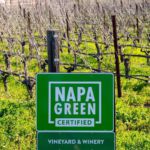It is out with the old and in with the new for Napa Green, which is now the first winegrowing certification program in the world to redevelop and overhaul their sustainability standards.
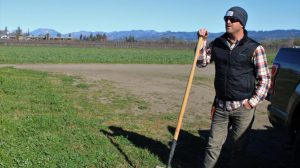
Jake Terrell of Sequoia Grove
Sequoia Grove is one of the first Napa Valley vineyards to adopt the new Napa Green Vineyard certification, with Jake Terrell at the helm of the operation.
photo: Sam Jones, Register
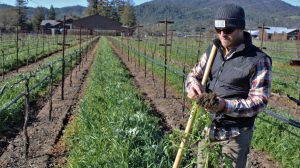
Jake Terrell digs up cover crop at Sequoia Grove
Jake Terrell, director of vineyards for Sequoia Grove, digs up cover crop to explain how it contributes to soil health.
photo: Sam Jones, Register
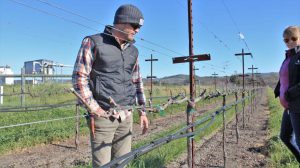
Jake Terrell and Kelly Allyn in the vineyard
Jake Terrell and Kelly Allyn of Sequoia Grove point out the dual drip lines in the estate vineyard, which are designed to cut down on unnecessary water use.
photo: Sam Jones, Register
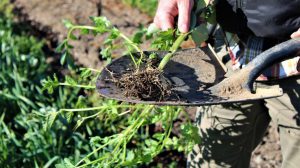
Cover crop close up, Sequoia Grove
Cover crop is one of the main tactics used by Sequoia Grove's Jake Terrell to manage soil health in the vineyard.
photo: Sam Jones, Register
Napa Green redevelops vineyard certification, hopes to set new sustainable standards
- Sam Jones | NAPA VALLEY Register|
- March 4, 2022
The organization’s new model — called the Napa Green Vineyard program — officially replaced the Napa Green Land program on Jan. 1, and the 42 members transitioning will have a year to adapt to the new regulations.
According to Napa Green’s Executive Director Anna Brittain, these 42 participants represent about 5,200 vineyard acres in the Napa Valley area.
“This all launched in 2004 with Napa Green Land, and at the time, those were really cutting-edge practices to prevent erosion and sediment runoff,” said Brittain of the now-defunct model. “In 2017 — and this is kind of what you want to have happen — those became a regulatory compliance requirement, so we sort of hope that with our new cutting- edge standards, in 10 years those will be a compliance requirement.”
At a basic level, the revised Napa Green Vineyard program looks at issues that were not at the forefront of the certification when the first version was drafted, most notably including climate action, regenerative farming and social equity. As a result, the program now has six main elements: conservation burning; tree and forest preservation; restricted pesticides; water efficiency; carbon farming; and inclusion — each of which has a set of mandatory and optional actions to take to meet certification requirements.
“It was time to really level up,” said Brittain. “But what we say to everyone is you don’t have to be an A-plus student to get certified … Everyone has to be like, B-plus to A-minus as I put it, and then they get an action plan.”
This action plan thus consists of tangible changes the vineyard crews can make, whether it be infrastructurally, administrative or mental. Such items include implementing annual performance reviews for staff, hiring farmworkers year-round rather than seasonally, installing flow meters to track water use, replanting with drought-tolerant rootstocks, and many, many more.
“They have to do more than a hundred things to be winery certified and another hundred things to be vineyard certified, so it’s overwhelming,” said Brittain. “We’re trying to make that manageable.”
Recertification for this new program will take place every three years, and during the site review, staff will update the vineyards’ new (and mandatory) Carbon Farm Plans.
“Then, we do annual desk audits to make sure they are still doing these things, and then we can see if any of the team members left and if any new ones come on, and we can get them up to speed with everything,” said Brittain.
One of the first five vineyards to be fully certified with the new program is Sequoia Grove Winery, where the director of vineyards Jake Terrell has been prioritizing sustainability for the past five years.
“Napa Green looks at the holistic view of sustainability,” he said. “You have your social side, so how you treat employees, do they have good healthcare, your safety, are you buying locally, is there room for advancement with your employees?
“And then they have the economic side, which is, are you actually a sustainable business that can continue to be going on and on for years?”
“And then, of course, like most people focus on, is the environmental side, which is, I think, especially in farming, where we actually have the most impact or can potentially have the most impact,” he added.
Sequoia Grove is active in the restoration of the Rutherford Reach, contributes to the Save the Redwoods League and is a member of the “1% for the Planet” group, but the work they do onsite is by far the most impactful. Terrell and his winery counterpart, assistant winemaker Kelly Allyn, say the winery is now fully powered by renewable energy through the Deep Green program with Marin Clean Energy, in addition to the company’s water reclamation and recycling initiatives.
“One thing that I also focus on a lot, and they focus on this as well with carbon sequestration and for the health of the soil, is cover cropping,” said Terrell.
Terrell explained how cover cropping with plants like barley can help build organic matter in the soil, as well as how others can fix nitrogen levels based on how each section of the vineyard is doing.
Terrell also shows off the vineyard’s dual drip lines, which are set up so that during times when more water is needed — such as after replanting a specific section of the vineyard — they don’t need to irrigate any more than absolutely necessary.
And while this is all great, these actions require money and time.
“I think the biggest barrier for most vineyard managers is that it’s a lot of paperwork, and you have a lot of stuff to do,” said Terrell. “And obviously Napa Green and Napa County Resource Conservation District and those organizations are helping you with all of this, but in trying to check out that barrier of entry, it’s a lot to do.”
At Dominus Estate, also one of the first portfolios to get certified with the new Napa Green Vineyard program, director of viticulture and winemaking Tod Mostero has been spearheading the effort to transition to the new certification standards.
“As a vintner, the biggest difference in terms of day-to-day tasks in transitioning to Napa Green Vineyard has been a deep, permanent shift in perspective,” he said. “With our current approach to sustainability, we question every practice and have developed a new relationship with our work, our environment, and our employees … We ask ourselves how each action is improving our relationship to water, waste, social equity, energy, pesticide reduction, soil health and climate resilience.”
As a dry-farmed vineyard, monitoring the quality and health of the soil is tremendously important for Dominus to ensure they keep producing top-tier grapes without sacrificing precious resources, so Mostero has found it helpful to be more thoughtful about their communication among staff.
For example, Mostero says at their daily morning meetings, the team reviews how much water they used the previous day, discuss what activities they engaged in and discuss how they could modify them to conserve more water.
“During our yearly reviews, we talk about how to improve relationships within the team, job satisfaction and the specific areas of interest of each member of the team, [and] on a daily basis, we check in to see how our colleagues are coping with COVID and financial stresses … All of this builds a sense of stability, strength and foundational sustainability.”
Mostero also says the Carbon Farm Plan portion of the new vineyard certification has required the most work for Dominus to transition, but that Napa Green and Napa County RCD have walked them through the process of maximizing sequestered carbon.
“Because of the complexity around this subject, and the considerable impacts we can make by farming regeneratively, it will certainly require the most focus and ongoing effort,” he said.
Over at Opus One, the fact that vineyard crews have been experimenting with biochar — which is a hot topic in the world of carbon sequestration — since 2015 was a great help in adjusting to these standards. Opus had their first successful biochar-producing burn in 2018, and in 2020, used an air burner unit which left them with an essentially smoke-free burn.
“It was a very smooth transition to becoming certified as a Napa Green Vineyard,” said Angela Muscarella, Opus’s production manager. “Once we defined the principles by understanding the ‘why,’ we immediately implemented practices that reflected the principles.”
“As a result, these practices became ingrained in our day-to-day tasks, and we were able to educate Opus One as a whole.”
For Clif Family Winery, president Linzi Gay says no major changes were necessary on their end, but that the new certification is definitely “more rigorous” and is optimized for accountability.
“The work is never done, and we can always be improving, both in our individual organizations and collectively as a wine community,” said Gay. “It is important for us to keep track of our progress and achievements, and to have accountability to these best practices if we want to see real impact.”
By Sam Jones
Napa Valley wine industry reporter
You can reach Sam Jones at 707-256-2221 and sjones@napanews.com.
Making the commitment to third party certification takes time and effort, but it is worth it to demonstrate our commitment to the community and to protect our watershed, our land and the air we breathe.
- Susan Boswell, Chateau Boswell Winery

